TYPES OF PACHINKO Machines
Single Shot
These machines load and fire one ball at a time, they come in Semi-Automatic (non-recirculating) and Automatic (recirculating) type machines. They were made from the 1940’s until the late 1960’s.
Semi-Automatic (non-recirculating)
The simplest mechanical, gravity-operated type. The entire operation of the machine is powered by gravity. Any lights are operated by a battery or power supply. As the game is being played, each ball that is shot into the game will drop out the back into a receiving tray. Each jackpot that is paid to the front comes from a separate bank of balls. Once the bank of balls has been emptied by scoring all the jackpots from it, the player re-loads the game back from the receiving tray in the back of the game to start the next game.
Automatic (recirculating)
A more sophisticated mechanical, gravity-operated type. This game has an additional RECIRCULATING tray built on the back which eliminates the need for a separate “receiving tray” as with the Semi-Automatic type. This feature makes the game completely self-contained. All the balls stay within the game as it is being payed. Each ball that is shot goes into the recirculating tray and each jackpot is paid to the front from the same recirculating tray. This way, the balls are being replayed until the player wins more from the recirculating tray than he loses to it, and then reloads for the next game. The game can be played much longer without reloading because of the recirculation of the balls.
Electric Semi-Automatic (non-recirculating)
This is a plug-in electrical Pachinko. No batteries are needed and it includes a 24-volt transformer. The playing board on this type is electrical and features penalty pockets which make the play of the game more competitive and challenging than the mechanical Pachinkos. The player attempts to keep scoring by avoiding one of the several penalty pockets.
Electric Automatic (recirculating)
The latest game from Japan. It features an electric refeeding system and automatic push-button game reset to start the next game. It also has an electric bell system which is designated to reduce the noise level of the play of the game.
About Pachinko’s Machines
Peace of History
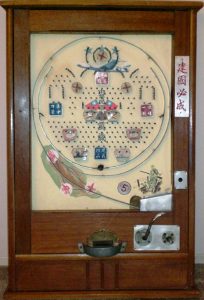 In 1929 the vertical machines gained universal acceptance. This vertical machine was called “Pachinko”, a reference to the sound of the game being played. In 1930 the Aichi prefecture headquarters granted the first ever license for the operation of a “Gachinko” hall, and it was in Nagoya. Gachinko was a play on words from a sumo wrestling term for a frenzied or fevered shooting forward move. Today the word means “Gonzo” or “fevered”, a predecessor of the so-called “fever mode” on modern electronic machines. The term is a throwback to the gachinko or “Fever” parlors of the 1930’s. Initially, these early pachinko machines were designed to dispense a small metal token or medal when a ball landed in a scoring pocket as a way of keeping score.
In 1929 the vertical machines gained universal acceptance. This vertical machine was called “Pachinko”, a reference to the sound of the game being played. In 1930 the Aichi prefecture headquarters granted the first ever license for the operation of a “Gachinko” hall, and it was in Nagoya. Gachinko was a play on words from a sumo wrestling term for a frenzied or fevered shooting forward move. Today the word means “Gonzo” or “fevered”, a predecessor of the so-called “fever mode” on modern electronic machines. The term is a throwback to the gachinko or “Fever” parlors of the 1930’s. Initially, these early pachinko machines were designed to dispense a small metal token or medal when a ball landed in a scoring pocket as a way of keeping score.
In 1936, The game of pachinko became an overnight sensation. In Kochi alone, 3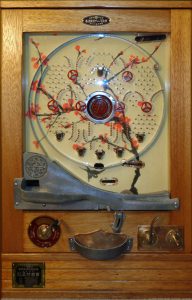 5 parlors opened in just six months. Late in 1936 pachinko machines appeared that had standardized 11mm, 5g balls, and the balls themselves were used to keep score. Unfortunately, there were few produced and they did not have the opportunity to become popular.
5 parlors opened in just six months. Late in 1936 pachinko machines appeared that had standardized 11mm, 5g balls, and the balls themselves were used to keep score. Unfortunately, there were few produced and they did not have the opportunity to become popular.
In 1937 the production of pachinko machines was halted because both the materials and the manpower were needed for the war in China. In 1938 all of the existing parlors were ordered closed.
After World War II, machines were once again produced and the pachinko parlors spread once more, beginning 1946 in Nagoya. Pachinko was played by many Japanese war refugees and the prizes were part of a subsidization program for them, almost as a food stamp program subsidizes the needy. The bigger the winner, the more commodity goods one could get. This way, the Japanese pride was not tarnished by accepting charity. Japanese society frowned upon accepting any form of charity. But by playing pachinko, they felt that they had been personally responsible for earning their own food. The players would take the balls and redeem th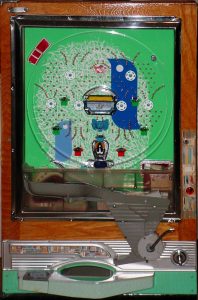 em for either food items or coupons worth so much toward the purchase of food.
em for either food items or coupons worth so much toward the purchase of food.
After Japan made her speedy recovery from the ravages of war, the game took on another characteristic for play. It was played much the same as games found on the American carnival midway. Pachinko was played just for fun and the most popular prizes were American cigarettes and other cherished imported items. Pachinko has been played all over the Orient, it was originally designed to be a diversionary or entertaining game for the Japanese.
In the early 1960’s the Japanese pachinko parlors became much closer to true gambling casinos. The game was played not only for prizes, but for money. However, because of underground connections, the game was suspected of being fixed. Many Japanese were losing their entire weekly paychecks by playing pachinko, whereas, before, they w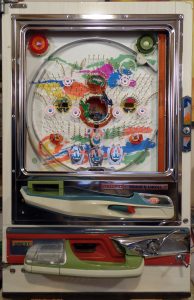 ere winning enough to support themselves.me In the late 1960’s, the Japanese government stepped in and prohibited the pachinko parlors from paying off in money. This significantly reduced the underground’s interest in the operation of pachinko parlors. This meant that the pachinko parlors reverted back to the way they had operated in the 1950’s. Today, the pachinko parlors are actually family entertainment centers with bright lights and lively colors. The whole family plays pachinko several hours a week. The parlors look very much the same as American bowling alley entertainment centers and video game arcades.
ere winning enough to support themselves.me In the late 1960’s, the Japanese government stepped in and prohibited the pachinko parlors from paying off in money. This significantly reduced the underground’s interest in the operation of pachinko parlors. This meant that the pachinko parlors reverted back to the way they had operated in the 1950’s. Today, the pachinko parlors are actually family entertainment centers with bright lights and lively colors. The whole family plays pachinko several hours a week. The parlors look very much the same as American bowling alley entertainment centers and video game arcades.
When Pachinko Parlors decommissioned the machines after about a year of use, they were sold cheap to make room for the newer models. Servicemen 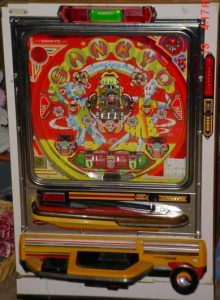 and businessmen started to bring them back to the US in the late 1940’s. There were hundreds of thousands of pachinko machines imported in the 1960’s and 1970’s. They were sold by Sears, Montgomery Wards, Target Abroad, Woolworth, Pachinko Palace, Spiegal, Pachinko Imports, The Pachinko Factory, Sutra Import, Kmart, Meshulam’s, Pier 1 Imports and others. When video games became popular, or when enough of the balls were lost which made the game unplayable, the pachinko machines were often put into storage and forgotten. The newer pachinko machines are still imported today and sold around the country as well as online.
and businessmen started to bring them back to the US in the late 1940’s. There were hundreds of thousands of pachinko machines imported in the 1960’s and 1970’s. They were sold by Sears, Montgomery Wards, Target Abroad, Woolworth, Pachinko Palace, Spiegal, Pachinko Imports, The Pachinko Factory, Sutra Import, Kmart, Meshulam’s, Pier 1 Imports and others. When video games became popular, or when enough of the balls were lost which made the game unplayable, the pachinko machines were often put into storage and forgotten. The newer pachinko machines are still imported today and sold around the country as well as online.
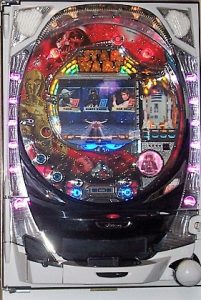 nd sound features. These became known as the early moderns. They were being crammed full of electronics. Every machine had a motorized center with lights and sound. These were known as the “Hanemono machines”. Later after those in about the mid 90’s they started putting in digital displays into every machine and they became known as Dejipachis.
nd sound features. These became known as the early moderns. They were being crammed full of electronics. Every machine had a motorized center with lights and sound. These were known as the “Hanemono machines”. Later after those in about the mid 90’s they started putting in digital displays into every machine and they became known as Dejipachis.